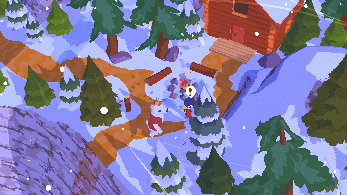An Achievable Open World - A Short Hike
4 min read
November 23rd, 2024
game design
Expect spoilers. This article takes a look at the game's design. If you don't want the game spoiled, stop reading.
I recently made the decision to play more single-player titles instead of same competitive multi-player games I've grown tired of in the last decade. To start that endeavor, I didn't want to pick up an AAA game with over 30 hours of gameplay -- that seemed daunting. I was looking for something small, which has the added benefit of being indie (usually more provocative and innovative given monetary limitations). I landed on a perfect title: "A Short Hike" by Adam Robinson Yu (adamgryu online). As I completed it, I realized there was beauty in how an obviously finite game felt like an achievable open world.
A Short Hike

You are an anthropomorphic bird visiting your aunt, who works as a ranger at a national park on an island. You decide that while you are at the park, you are going to hike to the top of Hawk's Peak. You can talk to the national park visitors, run some trails, climb the walls, glide, and more as you slowly make your way to the top. The premise is simple, and the game feels tight. Through clever design (level, narrative, etc), I was exposed to the mechanics necessary to explore the world without being told explicitly when to use them. Instead of hard, illogical boundaries, the island was architected in such a way that as I played and gained more abilities, I realized I could go back and explore that which I was unable to previously.

Before going further, what does "open world" mean? Open world games are loosely defined as games that aren't split into individual levels with a specific order. Instead, the player can explore a large portion of the game space in whatever way they see fit. Some popular open world titles are Skyrim, Assassin's Creed, and more recently Cyberpunk 2077. The narrative still progresses in a predetermined order and sets a few limits on what the player is able to do, but otherwise they are left to their own devices. Many games have done strong open world concepts (Breath of The Wild comes to mind), but a common pitfall of this type of game is the design of content that isn't the main narrative. It is time consuming (and expensive) to craft innovative and engaging experiences for every side quest. To alleviate this, procedural generation and other techniques are used to create content that appears unique without needing brand new art, logic, etc. However, this can only go so far. Players can tell the side content is hollow after experiencing it a few times. The challenge of large open world games is finding the balance between hand-crafted intentional experience design and procedural design, to make every aspect of the world worth exploring.
With this definition, A Short Hike fits the category of open world. Almost as soon as you learn the controls, you are left to do as you please. A lot of the progress you make is by discovery, which also means that no two people follow the same path to the end. But what makes it "achievable?" To me, it's:
The developers can create all the content for it without relying on gimmicks to inflate the time the player spend playing without receiving a meaningful reward (i.e. procedurally generated fluff).
The player thinks it is well worth their time to explore beyond the game's main narrative because the other content feels meaningful.
A Short Hike limited its own scope from the outset, and thus was able to craft every experience and interaction uniquely, building upon the same mechanics that are required to reach the peak. One of the side quests taught me how to cover more ground on the island faster, which was not required to reach the peak, but made the rest of my island exploration much easier. That's the kind of reward the incentivizes a player to continue talking to every character and walking off the main path. Other experiences were less directly useful, like learning to fish, but it fits the game's aesthetic very well: a calm and cozy way to pass the time.
![]()
None of the above means anything, however, if the main character movement loop was obtuse. In this case, A Short Hike excels. The variations in movement qualities are strung together in such a way that the act of traversing the island is entertaining unto itself. I spent a lot of time just combining running, jumping, gliding, and diving in different ways just because it was inherently fun to do so.
Through a high quality movement system and a well-defined and communicated (to the player) scope, A Short Hike manages to create a world that feels as good to explore as it does to complete. The creator did a wonderful in-depth breakdown of the development process at GDC, which you can check out here.
You can get any new thoughts to your inbox by subscribing.
